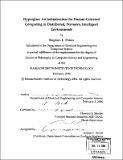Hyperglue : an infrastructure for human-centered computing in distributed, pervasive, intelligent environments
Author(s)
Peters, Stephen Leslie
DownloadFull printable version (10.54Mb)
Alternative title
Infrastructure for human-centered computing in distributed, pervasive, intelligent environments
Other Contributors
Massachusetts Institute of Technology. Dept. of Electrical Engineering and Computer Science.
Advisor
Howard E. Shrobe.
Terms of use
Metadata
Show full item recordAbstract
As intelligent environments (IEs) move from simple kiosks and meeting rooms into the everyday offices, kitchens, and living spaces we use, the need for these spaces to communicate not only with users, but also with each other, will become increasingly important. Users will want to be able to shift their work environment between localities easily, and will also need to communicate with others as they move about. These IEs will thus require two pieces of infrastructure: a knowledge representation (KR) which can keep track of people and their relationships to the world; and a communication mechanism so that the IE can mediate interactions. This thesis seeks to define, explore and evaluate one way of creating this infrastructure, by creating societies of agents that can act on behalf of real-world entities such as users, physical spaces, or informal groups of people. Just as users interact with each other and with objects in their physical location, the agent societies interact with each other along communication channels organized along these same relationships. By organizing the infrastructure through analogies to the real world, we hope to achieve a simpler conceptual model for the users, as well as a communication hierarchy which can be realized efficiently.
Description
Thesis (Ph. D.)--Massachusetts Institute of Technology, Dept. of Electrical Engineering and Computer Science, 2006. Includes bibliographical references (p. 161-165).
Date issued
2006Department
Massachusetts Institute of Technology. Department of Electrical Engineering and Computer SciencePublisher
Massachusetts Institute of Technology
Keywords
Electrical Engineering and Computer Science.